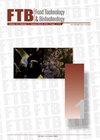异黄酮具有清除异味的潜在作用,IFS2是大豆种子中异黄酮积累的关键
IF 2.5
4区 农林科学
Q3 BIOTECHNOLOGY & APPLIED MICROBIOLOGY
引用次数: 0
摘要
研究背景。大豆(甘氨酸max (l))小麦是一种营养丰富的作物,含有高蛋白含量以及各种有益健康的生物活性化合物。然而,由于存在异味,它作为一种粮食作物的消费者接受度仍然有限。由于大豆中异黄酮的普遍存在、其固有的抗氧化潜能和对脂氧合酶活性的抑制作用,目前人们正在设想其在减轻风味方面的感官属性。实验方法。对17个大豆品种的异黄酮含量和组成进行了测定。以硫代巴比妥酸(TBA)数和羰基值为指标,建立了异黄酮谱与脂质过氧化的相关性。异黄酮合成酶(IFS)异黄酮异黄酮合成酶(isoflavone synthase, IFS)异黄酮异黄酮的克隆、基因表达分析和计算机分析。结果和结论。大豆基因型的总异黄酮含量从PUSA 40的(153.53±7.22)µg/g到Bragg的(1146.42±43.47)µg/g不等。黄染料木素与大豆苷元的比值(p<0.1)与脱味指标呈中度负相关。然而,发现与总异黄酮含量的关系不显著,暗示了复杂的相互作用在起作用。IFS2与其他生物合成酶的预测结构具有更高的蛋白质相互作用,并且在'Bragg'中的表达比IFS1高,这暗示了它在异黄酮合成中更重要的作用。创新和科学贡献。染料木黄酮与大豆苷元的比例是控制其变质的重要因素。IFS2被认为是产生高异黄酮含量大豆的关键基因,具有潜在的减少异味产生的潜力。本文章由计算机程序翻译,如有差异,请以英文原文为准。
Isoflavones Have a Potential Role in Off-Flavour Scavenging, with IFS2 as a Key in Isoflavone Accumulation in Soybean Seeds
Research background. Soybean (Glycine max (L.) Merr) is a nutrient-rich crop containing high protein content as well as various bioactive compounds with health beneficial properties. However, it continues to have limited consumer acceptability as a food crop due to the presence of off-flavour. Owing to the ubiquity of isoflavones in soybean, their inherent antioxidant potential, and inhibitory effect on lipoxygenase activity, their sensorial attribute in mitigating off-flavour is currently being envisaged. Experimental approach. The present study estimated the content and composition of isoflavones in 17 soybean cultivars. The correlation between isoflavone profile and lipid peroxidation was also established where thiobarbituric acid (TBA) number and carbonyl value were used as indices for the off-flavour generation. The cloning, gene expression analysis and in silico analysis of isoflavone synthase (IFS) isoforms were also performed. Results and conclusions. The total isoflavone content in soybean genotypes ranged from (153.53±7.22) µg/g for 'PUSA 40' to (1146.42±43.47) µg/g for 'Bragg.' There was a moderately negative correlation for indices of off-flavour generation with the genistein: daidzein ratio (p<0.1). The relation with total isoflavone content was however found to be insignificant hinting towards complex interactions at play. Higher protein-protein interactions for predicted structure of IFS2 with other biosynthesis enzymes and its comparatively higher expression in the 'Bragg' than IFS1, hinted towards its more substantial role in isoflavone synthesis. Novelty and scientific contribution. The genistein: daidzein ratio was found to be an important factor for controlling off-flavour. IFS2 was identified as a key for generating high isoflavone containing soybean with potentially reduced off-flavour generation.
求助全文
通过发布文献求助,成功后即可免费获取论文全文。
去求助
来源期刊

Food Technology and Biotechnology
工程技术-生物工程与应用微生物
CiteScore
3.70
自引率
0.00%
发文量
33
审稿时长
12 months
期刊介绍:
Food Technology and Biotechnology (FTB) is a diamond open access, peer-reviewed international quarterly scientific journal that publishes papers covering a wide range of topics, including molecular biology, genetic engineering, biochemistry, microbiology, biochemical engineering and biotechnological processing, food science, analysis of food ingredients and final products, food processing and technology, oenology and waste treatment.
The Journal is published by the University of Zagreb, Faculty of Food Technology and Biotechnology, Croatia. It is an official journal of Croatian Society of Biotechnology and Slovenian Microbiological Society, financed by the Croatian Ministry of Science and Education, and supported by the Croatian Academy of Sciences and Arts.
 求助内容:
求助内容: 应助结果提醒方式:
应助结果提醒方式:


